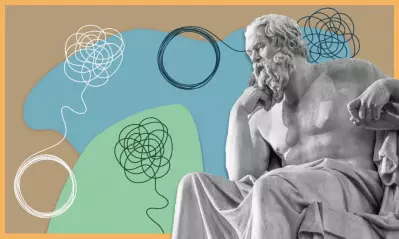How to write a teaching philosophy statement

Written by Michael Feder

Reviewed by Pamela M. Roggeman, EdD, Dean, College of Education

Creating a personal statement about teaching offers a chance for teachers to reflect on their classroom experiences and articulate their beliefs based on their observations. Here's how to get started writing one.
The importance of a teaching philosophy statement
Teaching philosophy statements map to educational learning theories such as constructivism, behaviorism, humanism and critical pedagogy. These learning theories provide a framework for understanding, interacting, and making sense of human behavior with regard to learning. They also influence how teachers instruct students.
A strong philosophy statement can help a teacher become more effective by helping to identify what works and what doesn’t, while providing a logical framework for adjusting an approach. It also provides a concise description of a teacher's professional approach to education to share with students, parents and colleagues.
What are the components of a teaching philosophy statement?
A teaching philosophy should include the following components:
- Beliefs about teaching and learning: What does the teacher believe is important in teaching? How do those beliefs impact how they teach, plan lessons and interact with students?
- Teaching method: Which approach does the teacher think are most effective? Teaching methods such as active learning, direct instruction and problem-based learning are just a few of the teaching methods an instructor may employ, based on content, context and students’ needs. What methods does a teacher prefer for evaluating student performance? How do they define success as a teacher? Do they see themselves as an educator who collaborates with colleagues or works independently?
- Goals for students: What does the teacher want students to be able to do when they leave the classroom? Are specific skills or competencies especially important?
Beliefs about teaching and learning
Beliefs about teaching and learning belong in a teaching philosophy statement because they are the foundation of how a teacher approaches their work It’s important to know a teachr's desires for student outcomes and whether they’re realistic for students.
Teaching isn’t just about imparting knowledge; it’s about leading and helping students learn how to learn. This means understanding where they’re coming from and what they need moving forward. That knowledge can then guide teachers in planning and instruction.
A good teaching philosophy will help a teacher stay focused on what’s most important in the classroom: students’ learning experiences.
Teaching methods
A teacher’s philosophy statement is a chance to showcase an instructor’s preferred teaching methods — and there are numerous teaching methods.
The most common is direct instruction, when instruction is mostly teacher-lead. Lecturing, one form of direct instruction, allows students to focus on processing information without the distraction of having to contribute, collaborate, question or challenge. Done too often or too poorly, however, and a lecture can become a dull experience that loses students’ attention.
Another common teaching method is project-based learning, when students work together to learn about a subject. This method encourages collaboration among peers and provides hands-on experience with real-world problems. The drawback? Students who lack strong research skills or who work better on their own may fail to learn essential lessons or skills.
Additionally, some teachers combine methods, such as lecture and discussion groups with hands-on activities sprinkled throughout the day. This method ideally allows students to experience the benefits of both types of instruction while mitigating the drawbacks. The trick is knowing which method to use and when for maximum efficacy.
Goals for students
One of the most important things a teaching philosophy addresses is the need to help students develop a love for learning. Stating how to approach this goal is a great way to describe teaching methods and creativity.
Another goal may be to help students become critical thinkers. Critical thinking involves analyzing information and coming up with conclusions based on what they've learned. Critical thinking is an essential skill students use throughout their lives to make well-informed decisions.
Finally, another goal might be to help students learn how to read critically. Critical reading means more than just reading words — it’s asking questions about what the author is saying, and it involves thinking about other ways of interpreting what’s written.
Where to find teaching philosophy statement examples
It’s important to have a clear vision for a teaching philosophy and to be able to share it with others. Here are some resources with examples:
- ThoughtCo.com
- YourDictionary.com
- TheBalanceCareers.com
Online education programs and master’s degree programs in education help teachers develop their teaching philosophy by allowing them to learn from mentors who have experience in crafting such statements.
These programs also provide opportunities for students to explore new ideas and reflect on their experiences relating to educational practices.
Writing guidelines for a teaching philosophy statement
A good philosophy statement is an important part of applying for most teaching jobs, and will show the interviewer that a candidate has thought carefully about their teaching style and what they hope to bring to the classroom. Here are some tips for writing a successful one.
- Be honest and transparent. This isn’t an essay that must dazzle an audience with wordsmithing. It’s a concise mission statement for an approach to classroom instruction. Stay focused on what to convey and use simple, direct language.
- Keep it short and sweet. The whole point of a philosophy statement is to give potential employers a quick summary of who a teacher is, so stick to the essentials.
- Proofread and revise multiple times. Errors, including spelling mistakes, can be a sign an applicant is not paying attention to detail or isn’t professional enough for the job.
- Read the statement out loud. This practice will help catch awkward phrasing or wording that doesn’t flow well. Are sentences in active voice instead of a passive voice? Use active voice when possible; it’s more engaging and easier to read.
Examples of teaching philosophy statements
These statements are personal and should be powerful. Do not copy anyone else’s but do use the following as a jumping-off point for how to craft one.
- “A teacher’s job is to help students grow into lifelong learners by providing a safe place to explore the world around them and equip them with the skills they need to navigate that world. I believe that students are capable of learning in different ways, and it’s my job as a teacher to find out how each student learns best. This allows me to adapt my teaching style while maintaining consistency, so students can feel like they’re getting something new out of every lesson.”
- “To teach is to learn. The most important thing I can do as a teacher is to be a student — to keep learning and growing with my students and to model that learning for them. I believe in the power of experience. I want my students to have an opportunity to take risks and try out new things so they can learn more about themselves and the world around them. I believe in collaboration. My favorite learning experiences are working with a team on a project, especially if it’s just for fun!”
A teacher's greatest asset is the ability to connect with students. Keep this in mind when writing. Put students at the center of the statement — they are unique individuals who deserve respect and every effort to help them succeed.
Do’s and don’ts of writing a teaching philosophy statement
Writing a statement can be challenging. It’s hard to distill beliefs and values into just a few sentences. Keep the following key things in mind to help make the process easier.
Do: Be genuine
Be genuine when writing. Communicate beliefs about teaching and learning, and avoid imitating someone else’s style. Be clear and concise about those beliefs.
Don’t: Use technical jargon
The best statements are simple, direct and easy to understand. Avoid technical jargon, acronyms, similes and metaphors in a statement, as they might be difficult for readers to interpret.
Do: Use concrete examples
One of the most important aspects is to provide concrete examples to illustrate points. Doing so makes beliefs more relatable and easier for others to understand.
Don’t: Write based on what others want to hear
Reflect on personal beliefs as an educator. Avoid trying to guess what others want to read.
Additional resources for writing a teaching philosophy statement
Here is a list of resources to help get started on a philosophy statement:
- WeAreTeachers: Classroom ideas and online advice for brand-new and experienced teachers.
- HelpfulProfessor.com: “57 teaching philosophy statement examples”: A long list of ideas to kick off brainstorming.
- Steven M. Cahn: “Teaching philosophy: A guide”: An insightful resource for writing a teaching philosophy.
- Jill Stamm: "Philosophy of education workbook: Writing a statement of beliefs and practices”: A newer, more brief hands-on tool to help craft a philosophy statement.
Find out more about teaching philosophy statements
Preparing for a career in education will help give you more confidence as you write a teaching philosophy statement. University of Phoenix offers education programs, including
- Bachelor of Science in Education/Early Childhood Education
- Bachelor of Science in Education/Elementary Education
- Graduate Initial Teacher Certificate/Elementary
- Graduate Initial Teacher Certificate/Secondary
Contact University of Phoenix for more information.

ABOUT THE AUTHOR
A graduate of Johns Hopkins University and its Writing Seminars program and winner of the Stephen A. Dixon Literary Prize, Michael Feder brings an eye for detail and a passion for research to every article he writes. His academic and professional background includes experience in marketing, content development, script writing and SEO. Today, he works as a multimedia specialist at University of Phoenix where he covers a variety of topics ranging from healthcare to IT.

ABOUT THE REVIEWER
As dean of the University of Phoenix College of Education, Pamela Roggeman has spent over a decade in higher education teacher preparation in both the public and private sector. Her experience has included national partnerships that help to advance thought leadership in the field of education. Dr. Roggeman also serves as the President of the Arizona Educational Foundation’s Board of Directors.
This article has been vetted by University of Phoenix's editorial advisory committee.
Read more about our editorial process.


